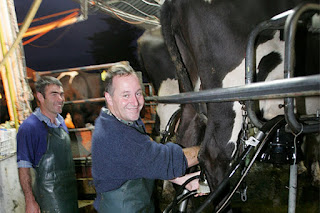"The environment can handle more"
The first state of the environment report since 2007, "Environment Aotearoa 2015", has just been released and what it describes is nothing to celebrate. Basically most of New Zealand's environment is far from good, our rivers are pretty much stuffed, our farmland is largely compacted by too many cows and while nasty exhaust fumes from cars have been reduced, we have increasing levels of green house gasses. We have twenty species that have not been seen for over 20 years and pests such as possums and rats are causing devastation in our national parks. Our fish stocks may be reducing at a slower rate but then the acidity levels in the sea are increasing and we have a growing number of marine mammals and seabirds verging on extinction.
John Key's response, "The environment can handle more."
The following statements are reproduced from the report and I'm wondering why it reads differently on Planet Key:
"Land use and population growth have placed increasing pressure on waterways. This is more evident with agricultural land because it surrounds 46 percent of New Zealand’s rivers. Between 1990 and 2012, the estimated amount of nitrogen that leached into soil from agriculture increased 29 percent. This increase was mainly due to increases in dairy cattle numbers (and therefore urine which contains nitrogen) and nitrogen fertiliser use. Once in the soil, excess nitrogen travels through soil and rock layers, ending up in groundwater, rivers, and lakes. Between 1989 and 2013, total nitrogen levels in rivers increased 12 percent, with 60 percent of the 77 monitored sites showing statistically significant increases. The greatest impact of excessive nitrogen levels in New Zealand rivers is nuisance slime and algae (periphyton) growth."
"In catchments dominated by agriculture, nitrogen in rivers comes mainly from livestock urine, and from nitrogen-based fertiliser. Between 1990 and 2012, the estimated amount of nitrogen that leached into soil from agriculture increased 29 percent (about 1.5 million kilograms a year). This increase was mainly due to increases in dairy cattle numbers (and therefore urine which contains nitrogen) and nitrogen fertiliser use. Once in the soil, excess nitrogen travels through soil and rock layers, and eventually ends up in groundwater, rivers, and lakes."
"Irrigation is the biggest consumptive user of water in New Zealand (consumptive use is when water is taken from a waterway but not returned). Based on resource consent information (which governs the amount of water a user is allowed to take), irrigation accounts for about three-quarters of consumptive water use."
"Compacted soils also affect land productivity. Soil compaction is evident on land used for farming animals for dairy, meat, wool, and velvet, and is made worse by higher stocking rates and heavier stock. Over half of the land used for dry stock and nearly 80 percent of soils under dairy farming are affected by compaction. This can adversely affect productivity because compacted soils can impede pasture growth and the capacity of the soil to hold water, resulting in greater run-off."
"The leaching of nutrients from farmland is an issue affecting our rivers, lakes, and estuaries. This happens when we apply more nutrients to the land than grass and other plants can use. When an excess of nutrients flow into waterways, they cause unwanted plants to grow, affecting water quality. Nitrate leaching has been an issue for some decades, but has grown in significance as farming intensified in many parts of the country."
"Many species face an ongoing threat of extinction. The extinction of one
species can detrimentally affect other species or even entire ecosystems. Since
humans arrived, hunting, habitat destruction, and introduced animals and plants
have resulted in at least 40 species being confirmed extinct. However, the
actual number of extinctions is likely to be substantially greater. For
example, at least 70 New Zealand species or subspecies have not been seen for
more than 20 years, but are still classified as ‘data deficient’ or ‘nationally
critical (data poor)’, rather than ‘extinct’."
"The most serious long-term pressures on our
marine environment are likely to be caused by climate change. Coastal sea
levels and long-term sea-surface temperatures around New Zealand have risen
over the last century, and our oceans are more acidic than when measurements
were first taken in 1998."
"More than one-quarter of our indigenous marine mammal species are
threatened with extinction, and the extinction risk of one mammal species, the
New Zealand sea lion, has increased since 2005. Māui’s dolphin is now one of
the rarest marine mammals in the world, with an estimated 55 individuals more
than a year old remaining. Ninety percent of indigenous seabird species and
subspecies that breed in New Zealand are threatened or at risk of extinction.
The risk of extinction has increased for seven of the 92 seabird species since
2005."




Comments